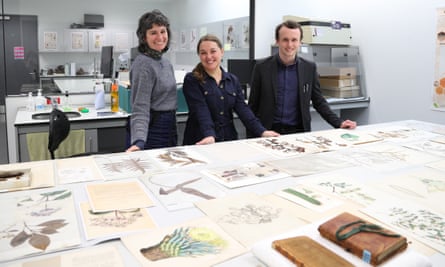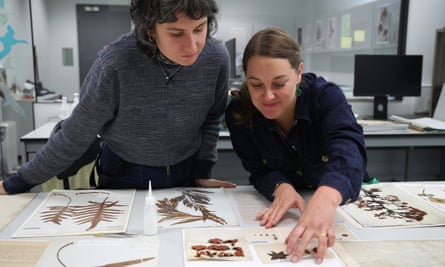After 200 years, Darwin’s plant specimens will finally be put on exhibit for the public to see.
Specimens of plants that were collected by Charles Darwin during his voyage on the Beagle have been discovered in an archive at Cambridge University.
The valuable plants, preserved in the Cambridge University herbarium for almost two centuries, were gifted by Darwin to his mentor and colleague Prof John Stevens Henslow, the visionary behind the creation of the Cambridge University Botanic Garden.
The public will soon have their first glimpse of these documents in a Channel 5 documentary which delves into the connection between Darwin and Henslow.
Dr. Edwin Rose, a science historian at Cambridge, stated that Henslow was a trailblazer in teaching botany and a valuable mentor to Darwin. Despite studying theology at Cambridge, Darwin took Henslow’s botanical course on three occasions.
In the early 19th century, Reverend Henslow taught a subject known as natural theology. This involved collecting various plant specimens in order to better comprehend the genius of the divine creator and their creation of the world, as explained by Rose. This was a significant motivation for studying the natural world during this time period.

In 1831, the aristocratic captain of the Beagle, Robert Fitzroy, was in search of a gentleman naturalist to join him on his voyage. After declining the role himself, Henslow suggested 22-year-old Darwin for the job.
Afterwards, Darwin dutifully sent plant samples to his former mentor. The responses he received, which commend his work but criticize his packaging, are still kept in the Cambridge University library for future generations.
According to Rose, anything that Darwin could gather and share with Henslow was considered valuable since Henslow was in the process of developing the botanical collection at Cambridge.
Henslow’s pedagogical program aimed to comprehend the vastness of God’s creation and the Creator’s design. This teaching resource was envisioned as a significant tool to aid in this understanding.
The university currently houses over 1,000 specimens collected by Darwin in its herbarium. This herbarium was founded in 1761 and now contains approximately 1.1 million plant specimens from various regions around the globe. It also includes 50,000 “type species,” which are the initial specimens used to define newly discovered species.
According to Rose, almost all of the plants that Darwin gathered and currently reside in the herbarium are considered type specimens. He was skilled at identifying species that were previously unknown to European scientists during his time. Almost everything he collected was completely unfamiliar to anyone in England.
This includes a specimen of cucumber that Darwin collected that is the only representative of that species known to scientists, implying it may now be extinct.
Despite being available to Cambridge researchers since its establishment, the herbarium’s contents have never been accessible to the general public. According to Rose, certain specimens gathered by Darwin have not been thoroughly examined.
The curators believe that these specimens may have remained largely undisturbed in the large herbarium collection since Henslow first received, identified, and recorded them many years before Darwin published his hypothesis of natural selection.
Rose said that there are still treasures awaiting examination by scientists.
Rose mentioned that a lichen, said to have been collected by C. Darwin in 1833, was discovered recently. It currently sits loosely on the paper it was preserved on and has not been attached or secured.

Rose explained that a different sample from Darwin’s fungal collection from Brazil was recently found in the original newspaper that he utilized to keep his discoveries safe while onboard the Beagle. This discovery showcases the techniques and obstacles involved in botanical collecting during the 1800s in tropical and damp settings when properly drying plants was a challenge.
According to the scientist, this gets us closer to the exact moments when Darwin personally discovered, protected, and packaged these specimens.
In 1833, Darwin gathered two examples of seaweed during his time on the coast of Tierra del Fuego. These samples align with letters written by Darwin in which he mentions the lasting impression of the vocalizations made by the Indigenous inhabitants of the South American islands upon his arrival at the shore.
An additional overlooked example that will be highlighted in the documentary “Susan Calman’s Great British Cities” on Channel 5 next Friday is the Opuntia cactus, also known as the prickly pear.
Darwin sent a sample of this species to Henslow, which was previously unfamiliar to Europeans. He made note of its role in the Galápagos Islands and observed that both lizards and birds relied on it as a key source of nourishment and hydration. According to Rose, this knowledge of the species’ relationships with its surroundings, such as its role in the food chain and its adaptation to unique environmental conditions, formed the basis of Darwin’s theory of evolution.
Source: theguardian.com

